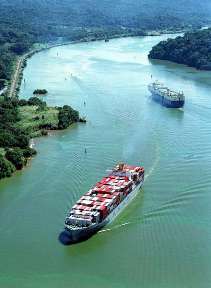The Panama Canal
Unlike any other civil engineering project ever undertaken, the construction of the Panama Canal captured the imagination of the world. It was one of the largest and most difficult engineering projects ever undertaken at the time, cutting through the Isthmus of Panama in Central America to connect the Atlantic and Pacific Oceans. In much the same way the Transcontinental Railroad reinvented shipping, the Panama Canal was a colossal engineering project which greatly impacted shipping between the two oceans by reducing the journey times immensely. Before the Panama Canal was opened on Aug. 15, 1914, a ship traveling from New York and San Francisco would have had to sail around Cape Horn, a 67-day, 12,000-mile journey. The Panama Canal provided shortcut between the Atlantic and Pacific Oceans, reducing the same New York to San Francisco by 4,000 miles.

The construction of the Panama Canal also captured the spirit of innovation that has always driven engineers, as they continued to build and learn from ideas used by their predecessors to eventually create one of the world’s marvels. It defines the characteristics and traits of successful engineering, from leadership, creativity, teamwork, communication and technical expertise. One of the most highly traveled waterways in the world, the Panama expansion project is expected to be completed in 2015. Furthermore, plans are underway to build yet another canal in Nicaragua in partnership with China.
The History
Dating back to the early 16th century, conquistador Vasco Nuñez de Balboa peaked up a summit in the Dariên region and realized that only a narrow strip of land separated the Pacific and Atlantic Ocean. Initiating a movement to build a passage across the Isthmus, Charles I of Spain ordered a survey of the region which was later termed an impossible feat.
Hundreds of years later, the French were motivated to take up the project after the successful completion of the Suez Canal. Ferdinand Marie de Lesseps, the builder of the Suez Canal, was appointed the leader despite the fact that he was not an engineer. He proposed a sea level canal be dug along the path of the Panama Railroad, believing that if it worked when constructing the Suez Canal it must work for the Panama Canal. They began to hack a broad pathway across the jungle using an impressive array of modern equipment, from steam shovels and locomotives to tugboats and dredges. Having visited Panama once (during the dry season) Ferdinand disregarded the warnings of men who were familiar with the Panama and this led to a series of challenges. Torrential rain, insects, snakes, swamps, heat, smallpox, malaria, yellow fever and the Chagres River all descended on the laborers, leading to thousands upon thousands of deaths. Mudslides buried men, supplies, and machines as time and time again, the rain and the Chagres destroyed what engineering and hard labor had wrought. The investors began to grumble over the lack of progress and the word ‘Panama’ quickly became synonymous with scandal and fraud. Finally, in May 1889 the company became bankrupt, and work was finally suspended. Twenty thousand men had lost their lives. While the canal remained unfinished, fifty million cubic meters of earth and rock had been moved and eleven miles of canal had been dug.
The US Isthmian Canal Commission of 1899-1901 was founded following failure of the French canal effort. The commission was created by Congress to examine the possibilities of a Central American canal and to recommend a route. At first they decided on a route that would cut through Nicaragua but later reversed its decision. They began negotiations with Colombia for a concession to build a canal through the Colombian province of Panama which failed. Impatient to start work on the canal, President Roosevelt supported Panama’s independence movement. Subsequently, they signed the Hay-Bunau-Varilla treaty with the new state of Panama, guaranteeing their independence and securing a perpetual lease on a 10-mile strip for the canal (now known as the Canal Zone). Panama was to be compensated by an initial payment of $10 million and an annuity of $250,000, beginning in 1913. Upon hearing their plans the French offered its assets to the United States at a price of $40 million.
Construction of the Panama Canal
The beginning of the U.S. canal construction began in 1904. By December 1905 there were 2,600 men at work in the Culebra Cut. Before work could begin, two things were dealt with: the type of canal that would be built and the fever that had plagued the French government’s workers. Chief Engineer John Frank Stevens’ lock-based model was eventually chosen, enabling the river Chagres to form a lake making up a large part of the canal route. Ships traveling toward the Pacific would enter the canal at Limon Bay, pass through a series of locks that carried them upward in step-like increments, navigate though the lake and descend toward Panama City through another series of locks. Medical researchers also became more receptive to the idea of a relationship between mosquitoes and malaria and yellow fever and started to carry out measures to contain these illnesses.
There were some salvageable remnants from the French, including buildings, supplies, dredged sea passages and eleven miles of canal. However, much of Americans’ first year in Panama mirrored the French disaster as the Chief Engineer (at the time it was John Wallace) neglected to develop an action plan. It was only when Engineer John Stevens took the helm that work on the canal really made progress. After establishing what model they would use and overcoming various sanitation challenges, gigantic steam shovels scooped tons of earth. Railroad cars ran continuously on a double track, dumping the tailings to form the Charges dam. Thereafter, Lt. Col. George Washington Goethals, an army engineer with lock expertise, became the new chief engineer. The Panamanian railroad that ran near the work was utilized fully. The crew used rock drills and dynamite to increase the efficiency of excavation. They managed to move 73 million cubic meters of earth and rock, under extreme heat and grisly accidents in the Culebra Cut, earning it the name “Hell’s Gorge.”
It took four years to build all of the locks which took their names from geographic names already in common use before the Canal was built. All lock chambers have the same dimensions and were built in pairs. A unique aspect of the waterway, the locks are heralded as a structural triumph of the Panama Canal. At the time of their construction, their overall mass, dimensions and innovative design surpassed any similar existing structures.
The workers poured enough concrete to build a wall that was 133 miles long at the Gatun Locks. The concrete work in Panama was an unprecedented challenge that would not be equaled in total volume until construction of Boulder Dam in the 1930s. They also built culverts the size of railroad tunnels to channel water from Gatun Lake into the locks. The last cement was poured at the Gatun locks in May, 1913 as steam shovels broke through the Culebra Cut. The Chagres filled the Gatun Lake and the engineers prepared for the canal’s first trial run which took place in September. A tugboat traveled through the first set of locks and out onto the lake flawlessly. Thereafter, the Panama Canal opened officially on August 15, 1914.
How the Panama Canal Works
The Panama Canal is a system of artificial and natural rivers and lakes allowing ships to get up over the terrain of Panama using locks to raise and lower the ships. The sea levels at the Atlantic and Pacific Oceans vary, hence the design of the system.
Coming in from the Atlantic Ocean, ships first pass through the Gatún Locks (a series of three lock sets), lifting vessels 85 feet to Gatún Lake. Once there, ships wind through the lake’s channel before entering the Gaillard (Culebra) Cut. After about 8 miles through the Cut, ships reach the Pedro Miguel Locks. These locks lower ships 30 feet to the Miraflores Lake, where they pass through a mile-long channel. They then go through the two-stepped Miraflores Locks that return them to sea level. A 7-mile passage takes them out to the Pacific. Overall the canal is about 50 miles long.
To raise a ship, water is released from a lake or from a higher lock through valves that open on the upper end of the lock. To lower a ship, water drains to a lower lock or to the ocean through valves that open at the lower end of the lock. The locks are powered by electricity. The dam at Gatun is able to generate the electricity to run all the motors which operate the canal as well as the towers for the ships through the canal. No force is required to adjust the water level between the locks except gravity. As the lock operates, the water simply flows into the locks from the lakes or flows out to the sea level channels. The canal also relies on the overabundant rainfall of the area to compensate for the loss of fresh water consumed during each crossing.
Expansion of the Panama Canal and Nicaragua
In 2006, Panama announced its plans to embark on a multi-billion dollar Panama Canal Expansion in a bid to double the waterway’s capacity. The deeper, wider channel will allow the passage of enormous vessels with up to three times the capacity of the biggest ships currently using the route. Most modern ships have increased in size, carrying up to 300,000 tons while the current canal can only accommodate ships carrying up to 65,000 tons of cargo. Furthermore, certain ships cannot fit through certain locks, driving them to seek alternative routes. Anticipated to be complete by 2015, the new waterway will allow larger container ships to pass through hence bigger cargo loads and in turn larger trade volumes between the Americas and Asia.
Nicaragua has also announced plans to construct its own interoceanic canal which could start in late 2014, after the country granted a Chinese company the concession for the project. It is expected to transform Nicaragua’s dream for a trans-ocean canal into reality. Already global engineers have voiced concerns about the canal’s route, which would certainly cross Lake Nicaragua. Should the project kick off, the water used by the canal’s locks could seriously deplete the lake. Global warming also means that even the Arctic may become a viable alternative to crossing Central America by canal.




Could you convey to me exactly what the primary snake is, my brother thinks you’ll find it a boa constrictor.
I would suggest that the author of this bit go back and read some history, particularly of the ERIE CANAL and its contribution to westward growth of the U.S. and the railroad system.